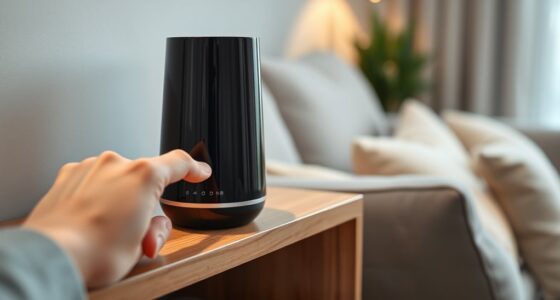When choosing between PoE and Wi-Fi cameras for security, consider their connection stability, security features, and installation needs. PoE cameras provide reliable, high-quality footage with wired connections that are less vulnerable to interference, making them ideal for critical areas. Wi-Fi cameras offer flexibility and easier setup, but may face connectivity issues. Both systems encrypt data and support user authentication, securing your footage. Keep exploring to discover which setup best suits your environment and security goals.
Key Takeaways
- PoE cameras offer wired connections, reducing interception risks and providing stable, high-quality footage for enhanced security.
- Wi-Fi cameras rely on wireless signals, which may be vulnerable to interference and hacking if not properly encrypted.
- Both systems use video encryption; PoE’s wired setup minimizes potential security breaches during data transmission.
- Regular firmware updates and strong authentication are essential for maintaining security in both PoE and Wi-Fi camera systems.
- PoE systems typically have centralized management, simplifying security monitoring and access control across multiple cameras.
Understanding Power Over Ethernet (Poe) and Wi-Fi Cameras

Power Over Ethernet (PoE) and Wi-Fi cameras are two popular options for home and business security, each with its own advantages. When choosing between them, consider camera resolution, which affects image clarity and detail. PoE cameras often offer higher resolutions, providing sharper footage, while Wi-Fi cameras can be limited by bandwidth. The user interface is also essential; PoE systems typically have a wired connection, leading to more stable and straightforward management via dedicated software. Wi-Fi cameras, on the other hand, often feature intuitive apps that simplify live viewing and settings adjustments from your smartphone or tablet. Additionally, network stability can influence the performance of Wi-Fi cameras, especially in areas with weak signal strength. Your decision should factor in the ease of use and clarity of the camera resolution, ensuring you get a system that’s both reliable and easy to operate.
Installation and Setup Processes for Both Systems

Setting up PoE and Wi-Fi cameras involves different steps that can influence how smoothly your security system gets operational. With PoE cameras, you’ll connect them to a network switch or injector, which supplies power and data through Ethernet cables. Mounting techniques often involve securing the camera to walls or ceilings using brackets, guaranteeing stability and ideal coverage. The user interface for PoE setups typically involves configuring the camera via a computer or network device, providing straightforward access to settings. Wi-Fi cameras, on the other hand, require connecting to your wireless network, often through a mobile app or web portal. Mounting may be simpler, as no cables are needed, but positioning is vital for signal strength. Both systems demand careful setup of their respective user interfaces to ensure seamless operation from the start. Additionally, understanding the effectiveness of eye patches can help you optimize your overall security and self-care routines, ensuring you look and feel your best.
Reliability and Connectivity Performance

Your camera’s reliability depends on its signal stability and range, which can vary between POE and Wi-Fi options. Network dependency and interference also play a big role in consistent performance. Understanding these factors helps you choose the best system for your environment. Additionally, selecting the appropriate connection type can significantly influence your camera’s overall effectiveness and durability.
Signal Stability and Range
When it comes to signal stability and range, POE cameras generally offer a more reliable connection because they use wired Ethernet, which isn’t susceptible to signal interference or signal loss over distance. You’ll experience consistent wireless coverage without drops caused by interference from other devices or obstacles. Unlike Wi-Fi cameras, which depend on your wireless network’s strength, POE cameras are less affected by environmental factors that can weaken signals. This results in fewer disruptions and more consistent footage quality. Proper installation practices also play a crucial role in maintaining optimal connectivity. With a wired connection, you won’t need to worry about signal degradation over longer distances, ensuring your camera stays connected and functioning ideally. Overall, POE cameras provide a stable, dependable signal, making them ideal for critical security setups.
Network Dependency and Interference
While Wi-Fi cameras rely heavily on your wireless network’s stability, their performance can be particularly affected by network congestion, interference, and signal strength issues. Wireless interference from other devices, such as microwaves or neighboring Wi-Fi networks, can disrupt the signal, causing lag or loss of footage. Network congestion, especially when multiple devices compete for bandwidth, can reduce the camera’s responsiveness and video quality. If your Wi-Fi signal is weak or unstable, you may experience frequent disconnects or blurry footage. Unlike PoE cameras that use wired connections, Wi-Fi cameras depend on a stable wireless environment. To improve reliability, confirm your network isn’t overloaded, minimize interference sources, and position your router ideally for a stronger signal. Additionally, understanding the art of Italian espresso can inspire you to create a cozy, well-designed space that complements your security setup and enhances your home ambiance.
Security Features and Data Protection

Both POE and Wi-Fi cameras prioritize security features to protect your data, but they approach this differently. POE cameras often use wired connections, reducing interception risks, while Wi-Fi cameras rely on wireless signals. Both types implement video encryption to secure footage during transmission, preventing unauthorized access. User authentication adds an extra layer of security, requiring you to verify identities before viewing or managing footage. Here’s a quick comparison:
| Feature | POE Cameras | Wi-Fi Cameras |
|---|---|---|
| Video encryption | Yes | Yes |
| User authentication | Usually more secure due to network | Often includes password and app-based security |
| Data protection | Wired connection reduces risks | Wireless signals require strong encryption |
Additionally, regular firmware updates are essential to patch security vulnerabilities and maintain optimal protection.
Flexibility and Placement Options

POE cameras offer greater flexibility in placement because they don’t rely on wireless signals, allowing you to install them in areas with limited Wi-Fi coverage or where a stable wired connection is preferred. You can easily position these cameras for indoor placement, such as hallways, lobbies, or offices, without worrying about signal strength. For outdoor mounting, POE cameras are ideal since they can be securely installed on exterior walls, fences, or poles, providing reliable coverage regardless of Wi-Fi reach. Their wired nature means fewer interruptions and more consistent video quality. This versatility makes POE cameras suitable for various environments, giving you more control over where and how you monitor your property without sacrificing performance.
Cost Considerations and Budgeting

Are POE cameras worth the higher upfront investment? While they tend to cost more initially, they can save you money over time. POE systems often have lower monthly expenses because they utilize a single Ethernet cable for power and data, reducing ongoing costs. Wi-Fi cameras may seem cheaper upfront, but they often require additional expenses like Wi-Fi extenders or higher bandwidth plans. When budgeting, consider the initial investment and long-term costs. POE cameras typically need a PoE switch or injector, which adds to initial expenses but can minimize future maintenance costs. Wi-Fi cameras might be less costly at first, but unreliable connections could lead to added expenses for troubleshooting or upgrades. Additionally, video quality can be affected by connection stability, impacting security effectiveness. Balance your budget with your security needs to choose the best option for your situation.
Maintenance and Scalability

When considering maintenance and scalability, you’ll want to think about how flexible your power supply options are and how easily you can expand your network. POE cameras often simplify system upgrades by enabling straightforward network expansion and integration, while Wi-Fi cameras may require more effort to add new devices. Understanding these factors helps you choose a solution that grows with your needs and stays easy to maintain. Additionally, being aware of Angel Numbers can provide insights into making intuitive decisions regarding system upgrades and scalability.
Power Supply Flexibility
Power supply flexibility considerably impacts both maintenance and scalability of security camera systems. With PoE cameras, your power source is centralized through Ethernet cables, reducing wiring complexity and simplifying maintenance. This setup allows you to easily add or move cameras without rewiring or managing multiple power adapters. In contrast, Wi-Fi cameras often rely on separate power sources, such as individual power adapters or batteries, which can complicate wiring and make scalability more challenging. If you need to expand or reposition cameras, Wi-Fi setups may require additional outlets or battery replacements, increasing maintenance efforts. Overall, PoE offers more flexible power solutions that streamline system growth and reduce ongoing upkeep, making it a more scalable and manageable choice for your security needs. Additionally, power management plays a crucial role in ensuring consistent operation and ease of system updates.
Network Expansion Ease
The way a security system handles adding new cameras directly affects its long-term viability. With Wi-Fi cameras, you enjoy greater wireless flexibility, making it easier to expand your network without running new cables. This simplicity means you can add cameras quickly, even in hard-to-reach areas. POE systems, on the other hand, rely on network scalability through Ethernet connections, which may require additional wiring and configuration. While POE offers reliable power and stable connections, expanding it can be more complex and time-consuming. If you value quick, flexible upgrades and minimal disruption, Wi-Fi cameras are advantageous. However, if you prioritize a scalable, wired network with consistent performance, POE might be better suited. Your choice depends on your expansion needs and the ease of maintenance. Additionally, understanding the network expansion ease of each system helps ensure your security setup remains effective and manageable over time.
System Integration Options
Choosing between POE and Wi-Fi cameras impacts how easily you can maintain and scale your security system. POE cameras often offer better integration compatibility with existing wired infrastructure, making system upgrades straightforward. They typically feature a centralized user interface, simplifying management and troubleshooting. Wi-Fi cameras, on the other hand, provide flexibility for adding new cameras without needing extensive wiring, but they may require more effort to ensure compatibility with your existing network and security protocols. Scalability with Wi-Fi cameras depends on your network’s bandwidth and the camera’s ability to connect seamlessly. Both systems benefit from user-friendly interfaces, but POE setups tend to offer more consistent stability for larger, more complex systems. Your choice influences maintenance ease and future expansion potential.
Suitable Use Cases and Environments

PoE cameras are ideal for environments where reliable, high-quality footage is essential and where a stable wired connection is feasible. For indoor monitoring, PoE cameras provide consistent, high-resolution video perfect for office spaces, retail stores, or homes. They’re also well-suited for outdoor surveillance, offering durability and steady performance in weather conditions. With a wired setup, you avoid interference and signal drops common with Wi-Fi cameras, ensuring continuous security coverage. PoE’s power and data delivery through a single cable simplify installation in fixed locations, making them ideal for permanent setups. Whether monitoring indoor activity or outdoor premises, PoE cameras deliver the reliability needed for critical security applications. They excel in environments where stability and high-quality footage are non-negotiable.
Making the Right Choice for Your Security Needs

When deciding between PoE and Wi-Fi cameras, consider what fits your specific security needs and environment. Think about camera aesthetics—do you want a sleek, discreet look or a more visible deterrent? Also, evaluate the user interface; some systems offer intuitive controls, making setup and management easier. Use this table to compare key factors:
| Feature | PoE Cameras | Wi-Fi Cameras |
|---|---|---|
| Installation | Requires Ethernet wiring | Wireless setup, flexible |
| Power Supply | Powered via Ethernet | Powered via adapters or batteries |
| Aesthetics | Usually more discreet | Varies, some bulky or visible |
| User Interface | Often advanced, customizable | Usually simple, user-friendly |
| Environment Suitability | Best for stable, wired environments | Ideal for flexible, remote locations |
Choose based on your aesthetic preferences and interface needs to ensure excellent security.
Frequently Asked Questions
Can POE and Wi-Fi Cameras Be Integrated Into the Same Security System?
Yes, you can integrate POE and Wi-Fi cameras into the same security system. Many modern security setups support camera compatibility across different types, allowing seamless system integration. You’ll want to check if your system’s components are compatible with both camera types. This flexibility lets you customize your surveillance, combining wired and wireless options for better coverage and convenience without sacrificing system cohesion.
What Are the Energy Consumption Differences Between POE and Wi-Fi Cameras?
Imagine you’re in a time machine, and today’s tech makes energy use feel like a walk in the park. POE cameras are more power-efficient, drawing power through the Ethernet cable, which reduces energy costs. Wi-Fi cameras, on the other hand, rely on wireless signals and typically consume more energy. So, if you want to save on energy bills and boost power efficiency, POE cameras are the smarter choice.
How Do Weather Conditions Affect Outdoor POE and Wi-Fi Camera Performance?
Weather impact can profoundly influence outdoor camera performance. For Wi-Fi cameras, rain, snow, or fog may weaken signals, causing interference and connectivity issues. POE cameras, being wired, are less affected by weather, but extreme conditions like heavy storms can damage cables or connectors. You should guarantee proper weatherproofing and choose cameras rated for outdoor use to minimize signal interference and maintain reliable surveillance regardless of weather conditions.
Are There Privacy Concerns Unique to Wi-Fi Versus POE Camera Setups?
Oh, the irony! Wi-Fi cameras seem to offer the convenience of wireless freedom, but that also means more privacy concerns. You might worry about data encryption lapses or network vulnerabilities, making it easier for hackers to access your footage. POE cameras, wired and seemingly more secure, still face risks if your network isn’t protected. Ultimately, both setups require vigilant cybersecurity to keep your privacy intact.
What Are the Long-Term Maintenance Costs for Each Camera Type?
When considering long-term maintenance costs, think about hardware durability and replacement expenses. POE cameras often have higher initial costs but tend to be more durable, reducing frequent replacements. Wi-Fi cameras are usually cheaper upfront but may incur higher replacement expenses over time due to potential connectivity issues or hardware wear. You’ll want to weigh these factors to determine which setup suits your budget and maintenance preferences best.
Conclusion
Choosing between PoE and Wi-Fi cameras depends on your needs, but remember, the right choice often comes down to what fits your environment best. Whether you prioritize reliability or flexibility, both systems offer unique benefits—sometimes, it’s just a matter of installation ease aligning with your security goals. In the end, your decision shapes not only your security setup but also the peace of mind you gain—sometimes, the simplest option turns out to be the most secure.









